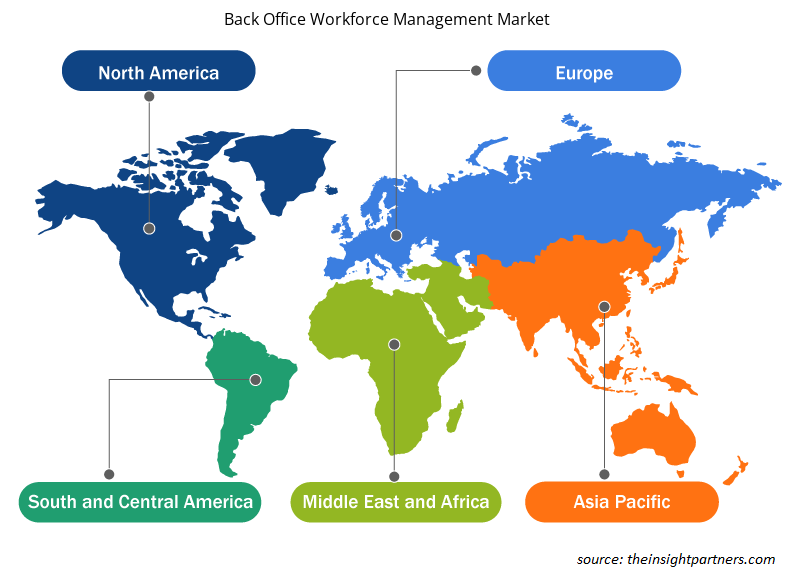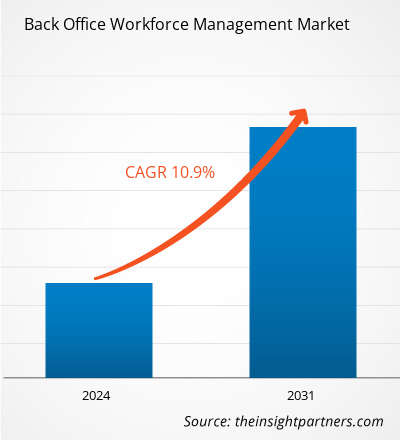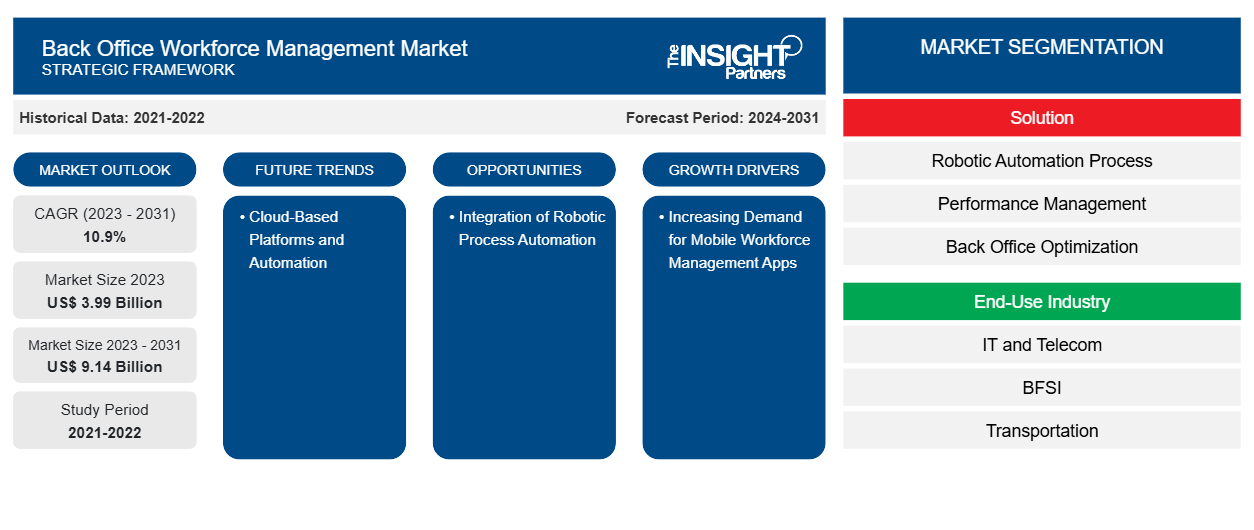Der Markt für Backoffice-Workforce-Management soll von 3,99 Milliarden US-Dollar im Jahr 2023 auf 9,14 Milliarden US-Dollar im Jahr 2031 anwachsen. Der Markt wird zwischen 2023 und 2031 voraussichtlich eine durchschnittliche jährliche Wachstumsrate von 10,9 % verzeichnen. Cloudbasierte Plattformen und Automatisierung werden voraussichtlich weiterhin ein wichtiger Trend auf dem Markt bleiben.
Marktanalyse für Back Office Workforce Management
Der Markt für Backoffice-Workforce-Management wird durch die Notwendigkeit der Personaloptimierung, die zunehmende Cloud-Bereitstellung und eine höhere Einhaltung verschiedener gesetzlicher Vorschriften angetrieben. Noch wichtiger ist, dass die Pandemie diesen Markt erheblich beeinflusst hat, indem sie die Einführung von Remote- und flexiblen Arbeitsvereinbarungen rasch beschleunigt und die Nachfrage nach Lösungen, die Remote-Arbeit ermöglichen, stark erhöht hat. Wichtige Marktteilnehmer und die Einführung transparenter , gerechtfertigter Mittel zur Mitarbeiterüberwachung wirken als wichtige Wachstumstreiber. Verbesserte Standards des Workforce-Managements durch die Integration neuer Technologien wie IoT und KI kurbeln den Markt ebenfalls an.
Marktübersicht für Back Office Workforce Management
Back Office Workforce Management bezieht sich auf die Verwaltung und Koordination interner Geschäftsabläufe, die nicht direkt mit Kunden in Verbindung stehen. Es umfasst umfangreiche Funktionen wie Buchhaltung, Bestandsverwaltung, Lieferkettenmanagement, Personalwesen, Logistik und IT-Dienste, um nur einige zu nennen. Das Back Office spielt eine wesentliche Rolle bei der Unterstützung der Ziele und Vorgaben des Front Office-Teams, indem es Aktivitäten im Zusammenhang mit Verwaltung, Datensatzpflege, Datenmanagement usw. übernimmt. Es kann außerdem eine effektive Verwaltung von Ressourcen, Technologien und Diensten umfassen, um einen ordnungsgemäßen Ablauf der internen Prozesse des Unternehmens sicherzustellen. Das Back Office ist wichtig für die Optimierung der Arbeitsbelastung, die Zufriedenheit von Kunden und Mitarbeitern und schließlich für die Verbesserung der Betriebsabläufe.
Passen Sie diesen Bericht Ihren Anforderungen an
Sie erhalten kostenlos individuelle Anpassungen an jedem Bericht, einschließlich Teilen dieses Berichts oder einer Analyse auf Länderebene, eines Excel-Datenpakets sowie tolle Angebote und Rabatte für Start-ups und Universitäten.
-
Holen Sie sich die wichtigsten Markttrends aus diesem Bericht.Dieses KOSTENLOSE Beispiel umfasst eine Datenanalyse von Markttrends bis hin zu Schätzungen und Prognosen.
Markttreiber und Chancen für Back Office Workforce Management
Steigende Nachfrage nach mobilen Workforce-Management-Apps
Unternehmen suchen zunehmend nach anwendungsbasierten Lösungen zur Verwaltung der Backoffice-Belegschaft mit dem Ziel, intelligente Arbeitsumgebungen zu schaffen. Bedenken, die Vorteile der Mobilität zu nutzen, werden auf lange Sicht aufgrund der daraus resultierenden Ineffizienz hohe Kosten verursachen. In dieser Hinsicht kann eine mobile Anwendung verwendet werden, um eine einzige Plattform bereitzustellen, die im Mittelpunkt der Schaffung einer konsistenten Erfahrung für die gesamte vernetzte Mitarbeiterbasis steht. Durch die Standortüberwachung können Unternehmen relevante Inhalte und Echtzeitbenachrichtigungen an die gesamte Belegschaft liefern, um zeitnahe und relevante Erfahrungen zu schaffen, die Effizienz, Produktivität und Mitarbeiterengagement gewährleisten. Mobile Anwendungen erleichtern das manuelle Eintragen offizieller Arbeitstage und aller anderen Details in das Datensystem. Sie fungieren als ein Ort, über den alle digitalen Berührungspunkte, die an der Verwaltung einer Belegschaft beteiligt sind, nahtlos integriert werden können. Die Konsolidierung arbeitsbezogener Ressourcen in einer App ermöglicht es einem Unternehmen hingegen, die reibungslose Arbeit der Mitarbeiter innerhalb oder außerhalb des Arbeitsplatzes zu verwalten und auch mit den Managementteams und Mitarbeitern zu kommunizieren und zusammenzuarbeiten. Die zunehmende Anerkennung der Vorteile mobiler, app-basierter Lösungen für die Personalverwaltung schafft Chancen für Akteure auf dem Markt für die Personalverwaltung im Backoffice.touchpoints involved in the management of a workforce can be seamlessly integrated. Consolidation of work-related assets into one app, on the other hand, enables an enterprise to manage the smooth working of employees inside or outside the workplace and also communicate and collaborate with the management teams and coworkers. The growing level of
Integration von Robotic Process Automation
Einer der wichtigsten Trends, die der Markt wahrscheinlich erleben wird, ist die Einbindung der robotergestützten Prozessautomatisierung in Backoffice-Workforce-Management-Lösungen. RPA ist definiert als ein Mechanismus, der vorschlägt, eine größere Anzahl von Betriebsaufgaben durch Roboter zu übernehmen, was wiederum die Effizienz, Produktivität und das Engagement der Mitarbeiter erhöht. Die neue Welle der Nachfrage nach Automatisierung von Personalaufgaben ist eine hervorragende Gelegenheit für die Akteure dieser Branche. Sie kann genutzt werden, um ihre Fähigkeiten bei der Betreuung neuer Unternehmen zu steigern, die auf die Optimierung von Betriebsabläufen und Mitarbeiterleistung abzielen.RPA is defined as a mechanism that proposes to acquire a bigger number of operational duties by robots, which in turn increases efficiency, productivity, and employee engagement. The new wave of demand for automation of workforce responsibilities is an excellent opportunity for the players involved in this industry. It can be used to gear up its capabilities in catering to new businesses that look toward optimizing operational processes and employee performance.
Segmentierungsanalyse des Back Office Workforce Management-Marktberichts
Wichtige Segmente, die zur Ableitung der Marktanalyse für Backoffice-Workforce-Management beigetragen haben, sind die Lösungs- und Endverbrauchsbranche.
- Basierend auf der Lösung ist der Markt in Roboterautomatisierungsprozesse, Leistungsmanagement, Backoffice-Optimierung, Prozessanalyse und andere unterteilt. Das Segment Leistungsmanagement hatte im Jahr 2023 einen bedeutenden Marktanteil.
- Basierend auf der Endverbrauchsbranche ist der Markt in IT und Telekommunikation, BFSI, Transport, Einzelhandel und E-Commerce, Regierung und andere unterteilt. Das BFSI-Segment hielt im Jahr 2023 einen bedeutenden Marktanteil.BFSI, transportation, retail and e-commerce, government, and others. The BFSI segment held a significant market share in 2023.
Back Office Workforce Management Marktanteilsanalyse nach Geografie
Der geografische Umfang des Marktberichts zum Backoffice-Workforce-Management ist hauptsächlich in fünf Regionen unterteilt: Nordamerika, Asien-Pazifik, Europa, Naher Osten und Afrika sowie Süd- und Mittelamerika.
In Nordamerika sind die USA ein wichtiger Markt, da viele Fortune 500-Unternehmen ihren Hauptsitz in dem Land haben, was die Nachfrage nach Backoffice-Workforce-Management-Lösungen antreibt. Die Einführung cloudbasierter Workforce-Management-Lösungen nimmt zu, da immer mehr Remote-Arbeitsmodelle zum Einsatz kommen. So können Unternehmen die Arbeitszeiten und die Produktivität von Mitarbeitern, die an verschiedenen Standorten arbeiten, effektiv überwachen.
Regionale Einblicke in den Back Office Workforce Management-Markt
Die regionalen Trends und Faktoren, die den Markt für Back Office Workforce Management im Prognosezeitraum beeinflussen, wurden von den Analysten von Insight Partners ausführlich erläutert. In diesem Abschnitt werden auch die Marktsegmente und die Geografie des Back Office Workforce Management in Nordamerika, Europa, im asiatisch-pazifischen Raum, im Nahen Osten und Afrika sowie in Süd- und Mittelamerika erörtert.

- Erhalten Sie regionale Daten zum Back Office Workforce Management-Markt
Umfang des Marktberichts zum Back Office Workforce Management
| Berichtsattribut | Details |
|---|---|
| Marktgröße im Jahr 2023 | 3,99 Milliarden US-Dollar |
| Marktgröße bis 2031 | 9,14 Milliarden US-Dollar |
| Globale CAGR (2023 - 2031) | 10,9 % |
| Historische Daten | 2021-2022 |
| Prognosezeitraum | 2024–2031 |
| Abgedeckte Segmente |
Nach Lösung
|
| Abgedeckte Regionen und Länder |
Nordamerika
|
| Marktführer und wichtige Unternehmensprofile |
|
Marktteilnehmerdichte im Back Office Workforce Management: Die Auswirkungen auf die Geschäftsdynamik verstehen
Der Markt für Back Office Workforce Management wächst rasant, angetrieben durch die steigende Nachfrage der Endnutzer aufgrund von Faktoren wie sich entwickelnden Verbraucherpräferenzen, technologischen Fortschritten und einem größeren Bewusstsein für die Vorteile des Produkts. Mit steigender Nachfrage erweitern Unternehmen ihr Angebot, entwickeln Innovationen, um die Bedürfnisse der Verbraucher zu erfüllen, und nutzen neue Trends, was das Marktwachstum weiter ankurbelt.
Die Marktteilnehmerdichte bezieht sich auf die Verteilung der Firmen oder Unternehmen, die in einem bestimmten Markt oder einer bestimmten Branche tätig sind. Sie gibt an, wie viele Wettbewerber (Marktteilnehmer) in einem bestimmten Marktraum im Verhältnis zu seiner Größe oder seinem gesamten Marktwert präsent sind.
Die wichtigsten Unternehmen auf dem Markt für Backoffice-Workforce-Management sind:
- NICE GmbH
- Open Text Corporation
- Oracle Corporation
- Genesys
- Alvaria, Inc.
- Verint Systems, Inc.
Haftungsausschluss : Die oben aufgeführten Unternehmen sind nicht in einer bestimmten Reihenfolge aufgeführt.

- Überblick über die wichtigsten Akteure auf dem Markt für Back Office Workforce Management
Neuigkeiten und aktuelle Entwicklungen zum Back Office Workforce Management-Markt
Der Markt für Backoffice-Workforce-Management wird durch die Erhebung qualitativer und quantitativer Daten nach Primär- und Sekundärforschung bewertet, die wichtige Unternehmenspublikationen, Verbandsdaten und Datenbanken umfasst. Nachfolgend sind einige der Entwicklungen auf dem Markt für Backoffice-Workforce-Management aufgeführt:
- Zapier, die Workflow-Automatisierungsplattform für kleine und mittlere Unternehmen, gab bekannt, dass sie das Team hinter Vowel, einem KI-gestützten Videokonferenz-Tool, für einen nicht genannten Betrag übernommen hat. Vowels CEO Andrew Berman wird der neue Director of AI bei Zapier. Durch diese Übernahme wird sich das Vowel-Team auf die Verbesserung der KI-Automatisierungsfunktionen von Zapier konzentrieren.
(Quelle: Inter Zapier Inc., Unternehmenswebsite, März 2024)
Marktbericht zum Back Office Workforce Management – Abdeckung und Ergebnisse
Der Bericht „Marktgröße und Prognose für Back Office Workforce Management (2021–2031)“ bietet eine detaillierte Analyse des Marktes, die die folgenden Bereiche abdeckt:
- Marktgröße und Prognose für Backoffice-Workforce-Management auf globaler, regionaler und Länderebene für alle wichtigen Marktsegmente, die im Rahmen des Berichts abgedeckt sind
- Markttrends im Backoffice Workforce Management sowie Marktdynamiken wie Treiber, Einschränkungen und wichtige Chancen
- Detaillierte PEST/Porters Five Forces- und SWOT-Analyse
- Marktanalyse für Backoffice-Workforce-Management mit Blick auf wichtige Markttrends, globale und regionale Rahmenbedingungen, wichtige Akteure, Vorschriften und aktuelle Marktentwicklungen
- Branchenlandschaft und Wettbewerbsanalyse, einschließlich Marktkonzentration, Heatmap-Analyse, prominenten Akteuren und aktuellen Entwicklungen auf dem Markt für Backoffice-Workforce-Management
- Detaillierte Firmenprofile
- Historische Analyse (2 Jahre), Basisjahr, Prognose (7 Jahre) mit CAGR
- PEST- und SWOT-Analyse
- Marktgröße Wert/Volumen – Global, Regional, Land
- Branchen- und Wettbewerbslandschaft
- Excel-Datensatz
Aktuelle Berichte
Verwandte Berichte
Erfahrungsberichte
Grund zum Kauf
- Fundierte Entscheidungsfindung
- Marktdynamik verstehen
- Wettbewerbsanalyse
- Kundeneinblicke
- Marktprognosen
- Risikominimierung
- Strategische Planung
- Investitionsbegründung
- Identifizierung neuer Märkte
- Verbesserung von Marketingstrategien
- Steigerung der Betriebseffizienz
- Anpassung an regulatorische Trends























 Kostenlose Probe anfordern für - Markt für Backoffice-Workforce-Management
Kostenlose Probe anfordern für - Markt für Backoffice-Workforce-Management